#star wars: visionaries
Explore tagged Tumblr posts
Text
Crew Headcanons: Jedi Consular Edition. Pt 1
- Nadia gets into trouble constantly for getting into everything.
-Qyzen is generally viewed by the others as a strange creature but a reliable guy.
-Courtesy of Zenith serval fights that could’ve been avoided were in fact escalated. Thanks to paranoia.
-Tharan is the number one cause of strife because of an addiction to playing the devils advocate.
-Felix is the voice of reason.
-Zenith has taken up pet sitting. Not one to just keep eye the animals, he actually does his best train said pets like they’re a K-9 unit. He’s very serious about it.
- Boardgames are competitive. Tharan was top dog but couldn’t resist sharing/bragging. So the others adopted his tactics and now Tharan has work to win.
- Zenith, Felix, and Qyzen spar and train together regularly. They also have shooting challenges.
-The guys all talk shop together about all things warfare (and tech).
-Everybody has time for Nadia. To teach her or talk to her.
- Tharan will do what he told but he does have running commentary about having to do it.
-Zenith and to lesser extent Felix are security nuts and are on everyone’s backsides to be vigilant.
-Qyzen and Felix are hunting buddies.
- Nadia and Felix can cook. So can Qyzen if like like meat. Zenith well he cooks but let’s say it tastes practical. Very practical and nutritious.
-Holiday the ship decorator no questions asked. She is also in charge of the crews schedules.
-Tharan is the most up to date on news and gossip because of Holiday.
#swtor#jedi consular#star wars the old republic#felix iresso#qyzen fess#zenith#nadia grell#holiday#nerd babble & headcanons#the visionary’s resolve#tharan cedrax#swtor companions
24 notes
·
View notes
Text

i wanna be that magnaguard, oh how i want it
#star wars#general grievous#the clone wars#qymaen jai sheelal#kaleesh#star wars grievous#kalee#revenge of the sith#star wars visionaries#the eyes of revolution
19 notes
·
View notes
Text

A Brief History of the Mandalorians by Leland Y. Chee (Star Wars Insider 115)
7 notes
·
View notes
Text

21 notes
·
View notes
Text
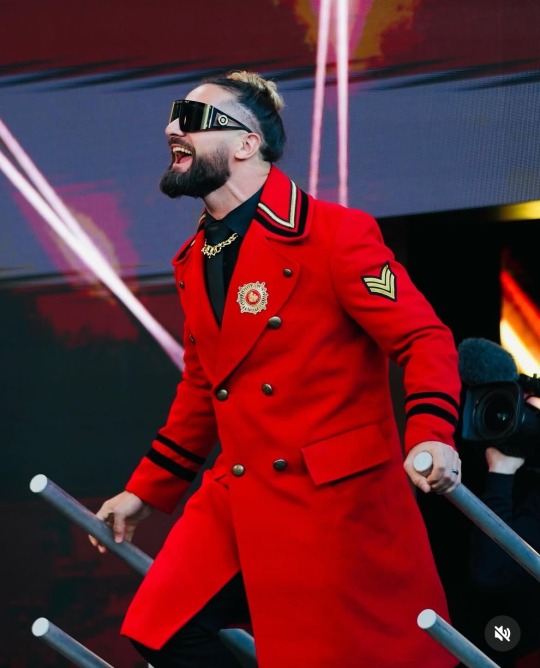


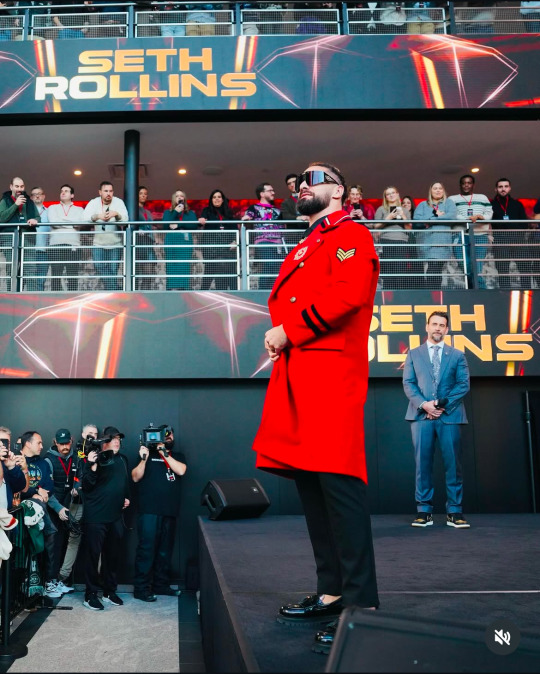
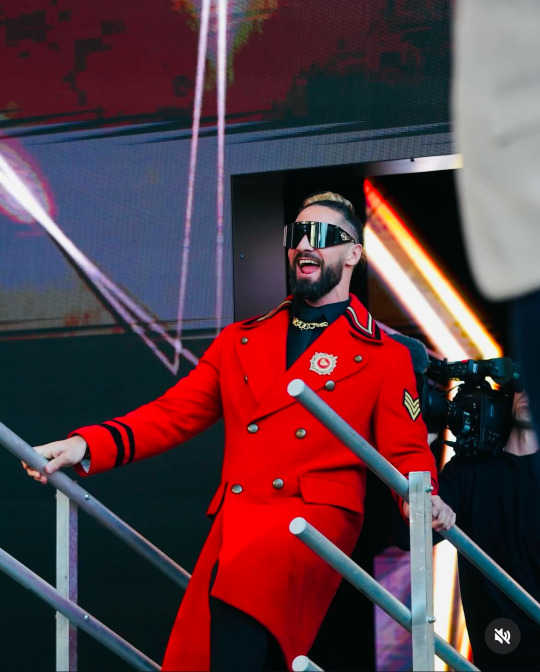
Guys,
#seth rollins#wwe#once again king trois caption slays#‘Star of the show The Visionary The Fashion Icon SETH ‘Freakin’ ROLLINS declared WAR in this RED MILITANT TRENCH’#🫶🏻🫶🏻🫶🏻
13 notes
·
View notes
Text
🌸 is in raptures of romantic ardor because i suggested we read the thrawn trilogy together as a "besties activity"
#i am being hailed as a great visionary.#we were bonding over our dissatisfaction with all recent star wars content relative to our respective preferred extended universe installmt#🌸: ''but andor WASN'T good! especially if you compare it to the dark empire comics run!''#and it turns out that neither of us had read all three thrawn trilogy books. so.#it's SO hot that theyre a really serious fan of the dark horse comics. i didn't even find out until we'd been together for years.
10 notes
·
View notes
Text
begging whoever is gonna write another star wars show or movie to please please get a functioning writer's room
#god the atrocities of ahsoka is just beyond words#star wars#in that same wachowski interview i was talking about the other day#they mentioned how the idea of#'one director one visionary' is rubbish#and like yeaahhh#that makes a lot of sense#why some disney stuff are the way they are
5 notes
·
View notes
Text
I feel so Thrawn when looking at Star Wars concept art. I could not beat Iain McCaig in a fight but I get it. I really do.
I do however absolutely believe I could beat George Lucas in a fight because he'd get scared if I shoved unused concept art into his face. Or just art of Women tbh.
#star wars#sw#george lucas is afraid of beauty and women I think#also symbolism#terrifieddddd#Dough Chiang Iain McCaig Dermot Power I love you#geniuses visionaries masterminds#should be in charge of all upcoming sw projects tbh#concept art#star wars art#just going through artbooks....#woah#i have personal faves but everything's just so damn stunning!#and the unused ideas have i mentioned George Lucas is a fucking idiot#'the three artists I've mentioned should've written the prequels tbh#with women in the writing room bc the prequels lacked that as a whole#but yeah i love their ideas sm
5 notes
·
View notes
Text
What really stood out in watching Jenny Nicholson's review of the Star Wars hotel is just that...Disney really can't do *anything* right anymore, can it? Objectively one of the most successful corporations ever in history, got where it was through legitimately high-quality product, visionary engineering, and obsessive attention to detail, and now...they just can't do anything. Guess that's oligopoly for you.
1K notes
·
View notes
Text
To Boldly Sew: The Creation of Star Trek's Iconic Wardrobe
Gene Roddenberry’s arguments with NASA, costumes crafted from shower curtains, male characters in miniskirts, and why the gold command uniforms were actually green—this is the story of Star Trek’s groundbreaking wardrobe and the visionary work of the man behind it, Bill Theiss.
If you’d like to read the formatted article with easily accessible references, you can also find it on AO3.
During the production of the original Star Trek, the creative team faced numerous challenges, the most persistent being, unsurprisingly, the show’s limited budget. These restrictions had a significant impact on many aspects of the series, including one of its most crucial visual elements: the wardrobe.
Each week, the costume department was tasked with creating original outfits for the show’s characters. Alien civilizations had to look distinct and believable without distracting from the storyline—all while staying within a tight budget. To achieve this, the team employed clever tricks, such as repurposing and dyeing old uniforms, turning garments inside out, and even fashioning costumes from unconventional materials like vinyl shower curtains.
"Sometimes a show will call for 30 or 40 costumes," explained Star Trek’s costume designer William "Bill" Theiss. "And since we film back to back, that means I have to design, get approval from the producers and director, and construct the costumes in six to eight days." [Source]

Commander Spock and Lieutenant Tormohlen don "protective suits" fashioned from shower curtains as they investigate the mysterious death of a mannequin crew member. (Season 1, Episode 4, "The Naked Time.")
Theiss was a key figure in shaping the visual identity of Star Trek’s universe. Over the course of the show’s three seasons, he designed costumes for a wide range of characters, from blue-skinned Andorians to the infamous Orion slave girls, and even the Nazi-inspired inhabitants of the planet Ekos. (Interestingly, the episode Patterns of Force, featuring Ekos, was banned from German television until 1995 due to its controversial themes.) [Source]
Theiss first met Star Trek creator Gene Roddenberry while Roddenberry was developing the show’s pilot. At the time, Theiss had gained attention for his innovative work on the science fiction play The Veldt, based on Ray Bradbury’s short story of the same name. This caught the eye of Star Trek writer Dorothy Catherine Fontana, who introduced Theiss to Roddenberry. By then, Roddenberry had already interviewed over a dozen costume designers but had yet to find someone who could bring his vision to life. Theiss’s creative approach, which often involved crafting unique costumes from unconventional materials, immediately resonated with Roddenberry. Their collaboration would continue for decades, even though, amusingly, Theiss never learned how to sew. [Source]
After the original Star Trek series was canceled, Theiss and Roddenberry remained close collaborators, working together on various projects until Roddenberry’s passing in 1991.


Left: William Theiss adjusts Susan Oliver's costume on the set of the 1965 pilot episode, "The Cage."
Right: William Theiss and Leonard Nimoy on the set of Season 2, Episode 26, "Assignment: Earth" (1968).
When designing Star Trek’s now-iconic multi-colored uniforms, Roddenberry drew inspiration from the color-coded uniforms used on American naval vessels, where quick role recognition was essential in low-visibility environments. As a former military pilot during World War II and later a police officer, Roddenberry had firsthand experience with structured, hierarchical organizations. These influences shaped not only Star Trek’s command structure but also its visual design. [Source]
Each division was assigned a distinct color: engineers, communications officers, and security personnel wore red; medical staff and scientists were dressed in blue; and command officers wore—believe it or not—green. (But more on that later.) All uniforms were paired with dark ash-colored trousers and high boots.
Star Trek is not typically associated with realism, which makes it surprising to learn that NASA was involved in the show’s production, offering advice to ensure it was "scientifically believable." Among their suggestions was the idea that 23rd-century astronauts might wear form-fitting jumpsuits. However, Gene Roddenberry dismissed the concept, humorously referring to the design as “long underwear.”
NBC, on the other hand, had entirely different priorities. The network insisted that female Starfleet officers wear more revealing attire, a demand that clashed with Roddenberry’s vision of a future where women were treated as equals to men. In the first pilot episode, The Cage (1965), Roddenberry boldly dressed female characters in pants—an unconventional choice for 1960s television. However, after much debate with the network, a compromise was reached: miniskirts. Highly fashionable at the time, they were paired with shorts and dark tights, blending contemporary trends with Star Trek’s futuristic aesthetic. [Source]

Captain Pike and a group of serious women in pants protect the heroine from an ass-headed very wise alien. The first pilot of Star Trek, "The Cage" (1965).
Years later, when NBC faced accusations of sexism and objectifying women, Nichelle Nichols, who played Uhura, defended the wardrobe choice in a BBC interview. She explained that the miniskirts weren’t unusual or inappropriate for the era:
“I was wearing them on the street. What's wrong with wearing them in the air? I wore 'em on airplanes. It was the era of the miniskirt. Everybody wore miniskirts.” [Source]
Grace Lee Whitney, who portrayed Janice Rand, echoed Nichols’s sentiment, adding that she “didn't think the women should be in pants” and that she wanted to “look like Flash Gordon” on screen. [Source]
Meanwhile, costume designer Bill Theiss had his own, more subtle approach to creating “revealing” costumes.
“He felt that revealing non-sexual flesh (the outside of the leg, off one shoulder, the back) promised that the viewer would see more — but they never did,” explained screenwriter D.C. Fontana, citing the gown worn by Lt. Palamas in Who Mourns for Adonais? as a prime example. [Source]
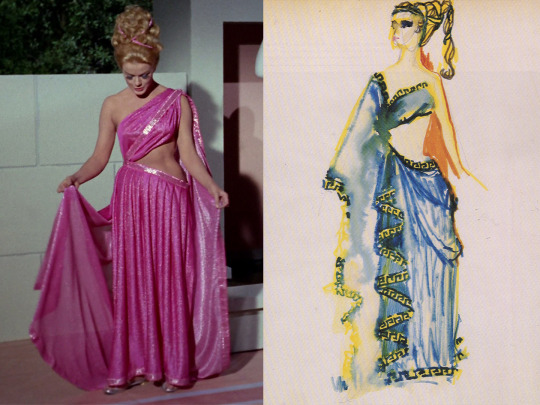
Lieutenant Palamas's "ancient Greek" dress from the episode "Who Mourns for Adonais?" alongside William Theiss's original sketch for the design.
When designing the original Star Trek uniforms, Theiss was tasked with creating something that reflected military influences while also looking futuristic and remaining inexpensive to produce. His approach was practical:
“As for where I get my ideas from… well, I don’t get them from my dreams or anything. Mainly, I get them from fabric that I see that’s available; I look for interesting patterns in the material itself,” Theiss once explained. [Source]
For the first two seasons, the Star Trek uniforms were made from velour, a newly invented fabric that was cheap, easy to maintain, and had an appealing sheen under studio lights. However, velour had its drawbacks: it tore easily (as evidenced by Captain Kirk’s frequent shirt-ripping battle scenes...) and shrank significantly after dry cleaning. Since the costumes had to be cleaned after every episode, viewers may notice that the uniforms became progressively tighter throughout the first two seasons. By the third season, velour was replaced with double-knit nylon, a more durable fabric used in professional baseball uniforms.
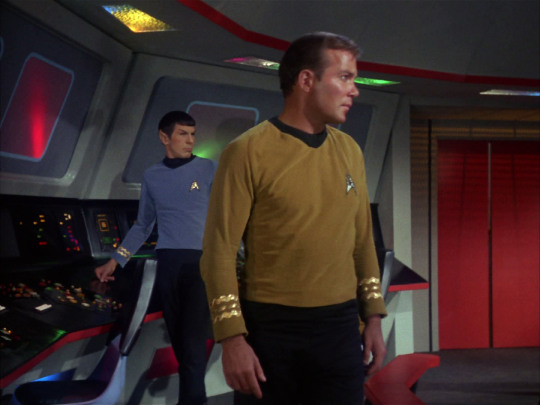

Left: Kirk's velour shirt from Season 1, Episode 10, "The Corbomite Maneuver." Right: The same shirt in Season 2, Episode 22, "By Any Other Name." Shatner is diligently sucking in his stomach.
This brings us to another interesting aspect of the original velour uniforms—their appearance on screen.
“It was one of those film stock things,” Theiss explained. “It photographed one way—burnt orange or gold. But in reality, it was another; the command shirts were definitely green.” [Source]
So, what color was Captain Kirk's uniform really? In truth, Kirk's uniform—like the rest of the command crew's—was olive green. However, under the bright studio lighting and the quirks of 1960s film stock, it appeared gold on screen. The greener hue becomes more noticeable in scenes filmed on location with natural light. The difference is also evident in photos of the original uniforms on display, such as those taken at an exhibit in Detroit, USA. In one image, taken under dimmer lighting without flash, the fabric looks closer to its true green color; in another, taken with flash, it appears more golden.


Left: Kirk's velour shirt photographed without flash—olive green. Right: Kirk's velour shirt photographed with flash—yellow gold.
This might come as a surprise to Star Trek fans, but it makes sense when you consider that Kirk's alternate uniforms—the wrap-around tunic and dress uniform—were distinctly green. This wasn’t an intentional design difference; those variations were simply made from a different fabric that didn’t react to light the way velour did.

“The problem is that a lot of my work is seen on screen for only two to three seconds, and even then, it might be in bad light or at a bad angle,” Theiss noted. “But then, you can't really justify taking two hours to light and block a scene just to showcase a costume.” The play's the thing, according to Theiss. "That's what it's really all about. It's not about the costumes." [Source]
The color discrepancy of the uniforms became an interesting challenge when animators began working on Star Trek: The Animated Series in 1973. They had to decide whether to depict the uniforms in their originally intended green or the gold shade that had become iconic to audiences.
At the time of Star Trek's release, many viewers were watching on black-and-white televisions, making it impossible for them to discern the true colors of the uniforms. At the Kirk/Spock convention, @kiscon, I spoke to a longtime Trek fan who told me she had no idea what color the uniforms were when she first watched the show as a teen. For those fortunate enough to see the series in color, however, the command uniforms became strongly associated with yellow. As a result, changing the uniforms to their intended green in Star Trek: The Animated Series would likely have confused audiences who had grown accustomed to the gold appearance on screen.
Ultimately, the gold uniform was canonized in The Animated Series and used in all fan materials until the release of the Star Trek feature films. Meanwhile, the trousers—whose color had also been slightly distorted on film—remained their original dark ash shade.
Because of these discrepancies, fans often debate which version of the uniform to follow when cosplaying or creating visual content. Many cosplayers choose to replicate the original olive-colored velour, trusting that proper lighting will naturally recreate the golden appearance seen on screen. Others opt for the now-iconic gold shade, reflecting the way the uniform has been depicted in official materials for decades.

Star Trek: The Animated Series (1973).
Ironically, NASA was right in its assumption that jumpsuits would become the norm for astronauts, and Roddenberry was forced to use them in the first feature-length Star Trek film, 1979's Star Trek: The Motion Picture. The multi-colored shirts were rejected by the studio as too garish, and the miniskirts worn by Uhura and most of the female crew members were already considered a relic of the sexist 1960s by 1979.
William Theiss, who designed the costumes for the original series, was too busy with other projects to work on the film, so Gene Roddenberry brought in a new costume designer, Robert Fletcher, who created the Starfleet uniforms now remembered as the worst in the franchise's history. In an effort to avoid comparisons to military uniforms, the studio opted for muted tones ranging from pale blue to dirty beige and nude shades. The result? The Enterprise crew looked more like spa staff than starship officers, and some background extras in nude-tone bodysuits appeared practically naked on screen. Not only did these uniforms make it impossible to distinguish the characters' ranks and departments, but they were also surprisingly impractical. The suits were sewn onto the actors' shoes, meaning they needed an assistant every time they went to the bathroom.

Star Trek: The Motion Picture (1979).
Luckily for us all, in the next film, Star Trek II: The Wrath of Khan (1982), it wasn’t just Khan who was filled with rage—the cast themselves rebelled and outright refused to wear the dreadful jumpsuits again.
Despite the failure of his design, Robert Fletcher remained as costume designer for the next three films, promising changes. In Star Trek II: The Wrath of Khan, the uniforms returned to a more military style, with the lead actors wearing maroon jackets with overlapping lapels that they could dramatically unbutton if their character was meant to look tired or stressed. If you look closely, you’ll notice that these maroon uniforms were actually redyed and slightly modified versions of the jumpsuits from The Motion Picture. The reason for the maroon color? It was the best shade that worked with the existing fabric from the first film. [Source]
William Theiss, reflecting on Fletcher’s designs, commented:
“Bob Fletcher is a very fine designer, and I mean that very sincerely. We don’t design the same way, and there’s no reason we should—or could. It’s apples and oranges. But my personal feeling is, if you go to a structured, woven fabric and do the kind of tailoring and structuring he’s done, it puts those costumes back, historically, 500 years, with shoulder seams and shoulder pads of that type.” [Source]
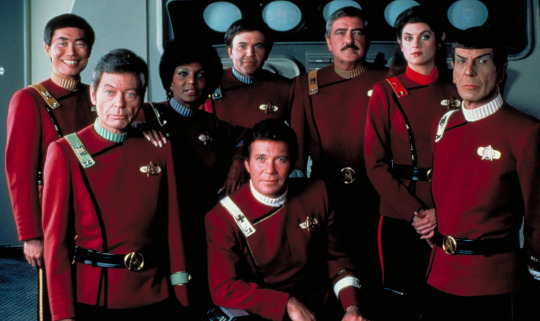
Star Trek II: The Wrath of Khan (1982). Everyone turned red with anger.
In Star Trek: The Next Generation, Roddenberry reunited with Bill Theiss, and together they decided to bring back the iconic miniskirts as part of the uniform, but with a twist—they wanted to make them inclusive. In The Next Generation, male crew members were occasionally seen wearing the same miniskirts or “scants” (a hybrid of skirts and pants), reflecting Roddenberry and Theiss’s vision of a future where gender norms no longer dictated clothing choices.
However, the social climate of the 1980s and 1990s wasn’t as receptive to this progressive idea.
“Having both actresses and actors in skirts was meant to diffuse any sexist accusations that might have been associated with designs from the old show,” Theiss explained. “It’s also fashionably probable that, 400 years from now, men would wear skants. Even so, there was usually a problem on the set,” he admits, “because some wisecracks were always made.” Theiss emphasized that he wanted his actors to feel at ease in the designs. “I won’t force an actor or actress to wear something they’re not at least 80 percent comfortable with.” [Source]

While Theiss’s designs were undeniably groundbreaking, he was known to be a challenging person to work with. Constantly preoccupied with time and budget constraints, Theiss had little patience for anyone—whether they were directors, producers, or even Gene Roddenberry himself. He was even less tolerant of people who approached him simply to praise or critique his work, or even just to say hello. His philosophy was simple: “Better to be rude than to delay filming.”
Actors, extras, and costume assistants often recalled how Theiss would dart around the set, frantically hemming, tucking, and adjusting costumes between takes. Many of the alien outfits seen on the show weren’t actually "costumes" in the traditional sense. Instead, they were often assembled from patches, ribbons, scarves, curtains, and wire, with actors being "stitched into" them directly on set. [Source]
For example, Janice Rand's iconic beehive hairstyle was crafted from several wigs braided together over a cone. Grace Lee Whitney, who played Rand, recalls running back and forth between the dressing room and Roddenberry’s office with Theiss, constantly piling on more hair. Each time, Roddenberry would stare at her intensely, then declare, “Higher!” Whitney and Theiss would rush back to add more wigs until the hairstyle reached its iconic height. [Source]
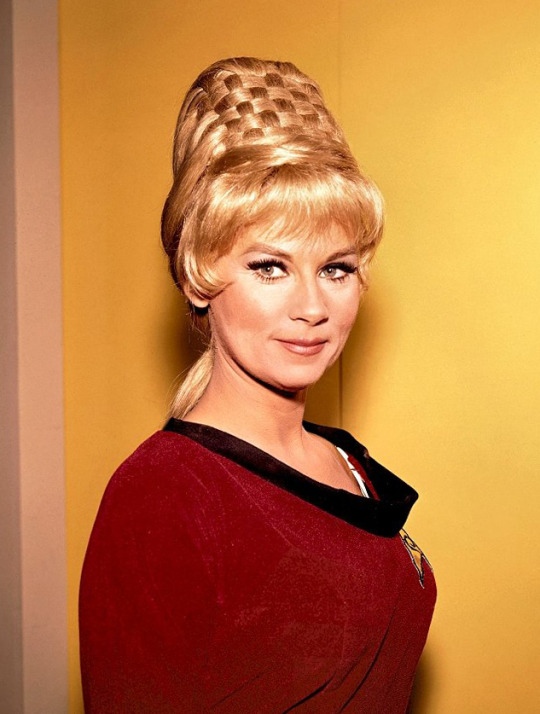
One Smithsonian Institute employee, who worked with Theiss in 1992 while preparing for a Star Trek costume exhibit, recalls combing through the Paramount warehouse filled with racks and boxes of costumes. She was amazed to discover that most of the "costumes" were actually scraps of fabric neatly hung on a single hanger. Yet, when these scraps were sewn, tied, and pinned together, they became the iconic designs we now associate with Star Trek.
Andrea Weaver, one of Theiss’s fellow costume designers on the original series, remembers:
“Bill Theiss was a creative designer. His designs for Star Trek were original, rather than distilled from other sources or redefinitions of previous works. This is what I appreciated about Bill Theiss. I thought he was a truly unique and rare costume creator.” [Source]
William Ware Theiss’s contributions to Star Trek are legendary. His uniforms for both Star Trek: The Original Series and Star Trek: The Next Generation remain iconic, instantly recognizable even by those who aren’t fans of the franchise. His innovative, DIY approach to creating futuristic costumes brought a distinctive charm to the original series and left an enduring legacy.
Here are some of his most memorable designs:


Left: Season 2, Episode 11: "Friday's Child" Right: Season 3, Episode 13: "Elaan of Troyius"
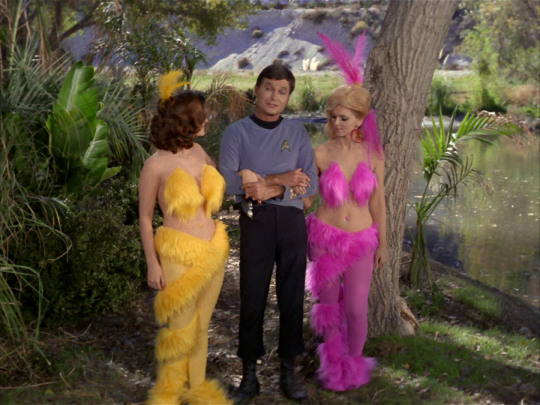

Left: Season 1, Episode 15: "Shore Leave" Right: Season 3, Episode 20: "The Way to Eden"
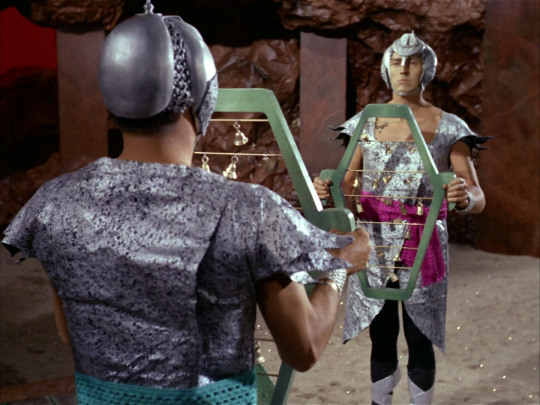

Left: Season 2, Episode 1: "Amok Time" Right: Season 1, Episode 23: "A Taste of Armageddon"


Left: Season 2, Episode 9: "Metamorphosis" Right: Season 1, Episode 6: "Mudd's Women"


Left: Season 3, Episode 5: "Is There in Truth No Beauty?" Right: Season 1, Episode 15: "Shore Leave"


Left: Season 1, Episode 23: "A Taste of Armageddon"Right: Season 2, Episode 16: "The Gamesters of Triskelion"


Left: Season 3, Episode 11: "Wink of an Eye" Right: Season 3, Episode 8: "For the World Is Hollow and I Have Touched the Sky"
#star trek#star trek tos#spock#kirk#s'chn t'gai spock#star trek the original series#star trek tng#star trek the next generation#star trek the motion picture#star trek the animated series#star trek the wrath of khan#articles#eldar of zemlya#captain kirk#james t kirk#behind the scenes#wardrobe#costume#costume design#costume department#filmmaking#gene roddenberry#bill theiss#william shatner#leonard nimoy
140 notes
·
View notes
Text
Elvira Gwandarae

Titles: Jedi Master, Barsen’thor, Paladin of House Organa.
Home Planet: Alderaan
Age:
About: Reserved and distant Elvira often acts as an anchor in times of hardship. She has a nack for gently telling the people want they need to hear, even if they don’t want to hear it.
Driven by insatiable need to know, and an aching sense of hope she follows the force with her ship the Visionary’s Resolve. Her journey has deepened her belief and understanding of the Jedi code. Though there are times when falls short of her own ideals, this is always something she struggles against.
Backstory: Elvira’s mother worked as a high end escort for Alderaan nobles and caught feelings for client from house Alde. Elvira was the result of this union though her mother elected not to tell the father or anybody else about Elvira. As she didn’t want to risk her child being taken away from her.
The first 6 years of Elvira’s life was with her mother. Where she learned manners and how to act professionally, as well as how to look nice. Then the Jedi order found her.
Because she was taken in a letter age she was always older than peers. This causes her to take on a mantle of maturity at a young age. She has a very strong connection to the force that makes her feel too connected to everything which leads to being overwhelmed. Elvira has a distinctly distant presence as if viewing events from afar as method of coping.
Fighting Style: Infiltration Shadow/?
She’s an infiltration shadow fighting the same way she negotiates by slightly nudging things in the direction she what them to go. Combat isn’t something that she rushes into but when she is fighting Elvira will give herself every possible advantage.
Her lightsaber form of choice is Niman, because of its versatility. Which for diplomat who never knows when a negotiation will go south is a must. It also the form that mixes the force with blade work best and provides more space for creativity. This some that Elvira values and the force heavily guides in combat so this style is very much an expression of that.
Elvira’s particular brand of Niman borrows some inspiration from Makashi. Not because she is skilled with form but because she hold an option that is most elegant of all the forms. This influence makes much better at one on one combat so much of her force work mid combat is forcing the enemy to face one at a time where she strongest.
Relationships:
Love Interest: Felix Iresso
Family:
Padawans: Nadia Grell (Force Bond)
Best Friends: Qyzen Fess, Felix Iresso.
Friends: Zenith, Tharan Cedrax, Holiday.
#swtor#star wars the old republic#jedi consular#elvira gwandarae#the visionary’s resolve#character intro
8 notes
·
View notes
Text
Article from Bloomberg by Jason Schreier, under a cut due to length.
"New ‘Dragon Age’ Game Faced Turbulent Development The studio head of EA’s BioWare says ‘Dragon Age: The Veilguard’ received nothing but support from EA throughout its lengthy production cycle EA’s BioWare label hopes to find redemption with the release of Dragon Age: The Veilguard Today we’re getting in-depth on the new Dragon Age game A new age for dragons In late 2020, when Gary McKay took over as studio head of BioWare, the Electronic Arts Inc. subsidiary best known for making big roleplaying games, the climate was dire. BioWare, which is headquartered in Edmonton, Alberta, had released two critically panned games and was facing turbulent development on a new one — while trying to cope with a worldwide pandemic. “We needed to shift how we were thinking about building our games,” McKay told me in a recent interview. BioWare, founded in 1995 and purchased by EA in 2007, had won over millions of fans with hit single-player RPG franchises such as Dragon Age and Mass Effect. But a 2017 entry called Mass Effect: Andromeda was widely panned, and the studio’s next game, the 2019 multiplayer shooter Anthem, flopped both critically and commercially. Both games had also gone through brutal development cycles that drove many BioWare veterans to exit the studio. At the end of 2020, studio boss Casey Hudson was planning to step down and called McKay to ask if he would take over. “We had a few conversations over the course of the next month around the people and the culture,” McKay said. BioWare’s next big project would be a new game in the popular fantasy Dragon Age franchise. But the game, which had been in development for years, was facing turmoil and had been rebooted from a single-player game into a live-service game with a heavy multiplayer component, which EA had been pushing across many of its subsidiaries in the late 2010s. Hudson, too, was interested in multiplayer games and had been the lead visionary on Anthem. Some employees jeeringly referred to the next Dragon Age as “Anthem with dragons,” which worried fans after I reported on the game at Kotaku. Enthusiasts of the series wanted another single-player game, not a repeat of BioWare’s biggest mistake. When he took over, McKay began to feel similarly. “We were thinking, ‘Does this make sense, does this play into our strengths, or is this going to be another challenge we have to face?’” McKay said. “No, we need to get back to what we’re really great at.” In the months that followed, McKay met with leadership across BioWare and EA and ultimately decided to reboot the next Dragon Age a second time, pivoting back to single-player."
The choice was obvious in many ways. Anthem had flopped while EA’s Star Wars Jedi: Fallen Order, a single-player action-adventure game, had sold more than 10 million copies, helping prove to the publisher that not all of its games needed to be online. BioWare games were popular because of their focus on character dialogue and player-driven narrative decisions, which did not mesh with multiplayer gaming. “Once we made that decision, a lot of things started to fall into place,” McKay said. In the years that followed, he would go on to consolidate more of the studio’s projects, shutting down an attempt to reboot Anthem and selling off the rights to the online game Star Wars: The Old Republic to a separate studio. The goal, McKay said, was “focus.” BioWare then spent the next three-and-a-half years developing what would become Dragon Age: The Veilguard, the fourth game in the franchise. Out this week, the game has received mostly positive reviews and so far topped charts, although EA has not yet revealed sales numbers. Some things went right during development. McKay said they “had the game end-to-end playable” earlier than any previous BioWare product, allowing them to spend extra time iterating. A reorganization at EA, which split the company into divisions called EA Games and EA Sports, allowed Dragon Age: The Veilguard to receive more support from internal teams that might otherwise be stretched thin, such as research and data insights groups. “That gave us an extra boost in terms of the support and focus from the company,” McKay said. But the development of Dragon Age: The Veilguard still faced plenty of obstacles. The pandemic led BioWare to shift to hiring remotely, which McKay said made for cultural challenges. The game slipped past its original target date, although McKay wouldn’t say how much extra time it needed. “I’m never going to call it a slip,” he said. And it went through significant scope changes over the course of development. Then, last summer, BioWare laid off 50 people, including veterans with decades of experience. McKay told me the reduction, which arrived during a period of widespread layoffs across the video-game industry, “was all about focus at that time.” “When you have a really large team, you’re always compelled to keep everybody busy all the time,” he said. “When you have a smaller team, you have the right people in the right roles at the right time, some incredible momentum is gained at that point.” The stakes are high for the release of Dragon Age: The Veilguard. Fans and pundits have worried that a third failure in a row might have devastating results for BioWare. McKay wouldn’t comment on the specifics of what would make the game a hit in their eyes. But said he has felt supported by EA Entertainment & Technology President Laura Miele. The game is so important to BioWare’s future that the company brought in its second team, which has been incubating a new Mass Effect, to help out during the final stretch of development. The Mass Effect team played a major role in finishing and polishing Dragon Age: The Veilguard. Other companies across EA, such as its Motive studio in Montreal, also supported the game. Now, the company will look to see how players react to the next Dragon Age — and, McKay hopes, “bring BioWare back into the conversation as a top game studio.”
[source]
#dragon age: the veilguard#dragon age: dreadwolf#dragon age 4#the dread wolf rises#da4#dragon age#bioware#video games#longpost#long post#covid mention#mass effect#mass effect: andromeda#mass effect 5#sw:tor#anthem#(this is from nov 1. but i'm still looking through backlog piles of headlines from the time i was hiding in the spoilerbunker so this post#is late)
91 notes
·
View notes
Text
Mutuality
A WaveWave (Soundwave x Shockwave) fanfiction I had sitting in my notes app since June.
I'm so normal about them ✍(◔◡◔) <(💜💙💜💙...) Spreading Wavewave propaganda all around!!!
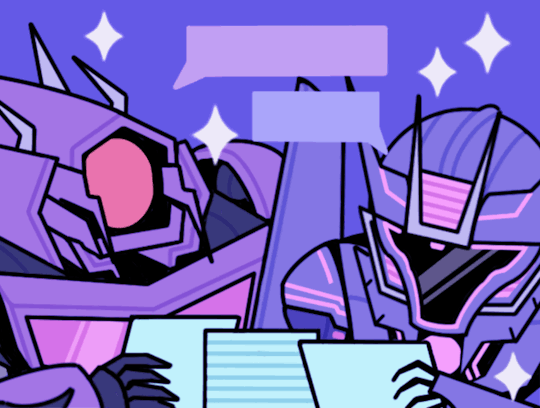
~~~
Everything they’d established was mutual. Everything was temporary.
Yet…
Soundwave worked through long cycles at a time. Although Vehicons worked as equals with said con, they would often head out in herds and murmur amongst themselves, turning towards their higher upper in ignorant secrecy. “He wouldn’t go… Workaholic… Always so quiet…” They would say and leave, yet the communication officer didn’t care. He liked it alone. He… was alone.
Being alone wasn’t too bad as Cybertronians put it to be. Sure, all sentient beings such as humans are social creatures. Why wouldn’t a biological AI be? Soundwave scoffed in silence, amused by discussions of socializing and friends, some bot to lean onto. He has no need for that, but somehow in some way, he still felt empty.
Mega-cycles prior to the events of the Civil War, he was just a gladiator within the rings of Kaon. Almost besting even the then most notorious Megatrous, and as an ex-senator, he had ways to keep himself occupied. Soundwave was as loyal as Orion Pax to Megatrous. The latter would then become the last Prime and Megatron’s archenemy, but Soundwave saw the light Megatron envisioned and showed. The Decepticon saw himself as the only one deemed inseparable from the Decepticon cause and to Megatron until he was wrong.
Shockwave… was a newcomer and was immediately impressed by this visionary. He devoted himself to the cause with the knowledge of science at the back of his servo. He was of great use; easy to bond with if you were Megatron.
… If you were Megatron… or…
Soundwave found himself side to side with Shockwave when calculating the future events that would behold on their precious planet. They hardly talked. Well, Soundwave never did, but it seems as if Shockwave could read his thought processor and always understood him no matter the situation.
They found themselves together through their work and even areas of leisure. Each one’s company filled the other with unexplainable warmth, craving it yet never so close. It was vulnerable and bitter, but also sickly sweet.
Everything they had was mutual. Everything was temporary.
Shockwave never returned to the Nemesis after their last battle at Cybertron. He assumed he sacrificed himself for the fruition of the Decepticon cause… or lost his life to a disposable Autobot. However, he kept those words to himself as he always did. He never showed his concerns. Not even the worries of a lost friend…
Thoughts of Shockwave bored into his processor as days went on.
When Shockwave did come back, Soundwave held his tempered emotions between his empty exterior, wondering still thoughts and muted feelings. As the meek Starscream and honorable Megatron discussed the whereabouts of Shockwave’s new discovery, Soundwave turned his HUD mask to that scarlet orb of a con. He stared at Shockwave, spark still alight.
Soundwave found Shockwave admiring the space of blue and violet at the Nemesis’s large interior window. Soundwave usually patrolled the corridors before heading to his berth. It was a mere task any mech can do, but he found it as an excuse to clear his mind off of the stress the crew caused numerous times, be it their own or the Autobots.
He stood by Shockwave, neither inching closer or away. He too glanced up at the night-lit aurora that passed through each universe. The stars reflected on SoundWave’s screen; it was beautiful.
“Surely my disappearance didn’t cause too much of a strain for Megatron or the faction,” Shockwave started, his free limb swayed to meet his chassis as red optic focused on Soundwave.
Soundwave shook his helm. “Negative: Decepticons, steady process.”
“You?”
“Affirmative: Soundwave… ” He stopped himself. He couldn’t start now. How uncharacteristic it would be, the silent and vicious Communication Commander, speechless for words. But even then, he wouldn’t lie to Shockwave, so why now?
“Troubled.”
Shockwave nodded the best he could for an Empurata. “I expected as much, for a high command, you are valued - for me, not as much.” His partner resisted the urge to scoff, to break the vow of silence to argue it was not. However, he said nothing. Instead, he turned to Shockwave and latched his paper-thin fingers over Shockwave’s oppositely sharp ones. They mindlessly took hold of each other’s small embrace, their figures never unmoving until their chassis touched and faceless helms pressed into gentle bliss.
As opposed to Soundwave’s cold exterior of a vision field, Shockwave was hot, radiating heat that warmed the equally cold-sparked mech. The way Soundwave cooled Shockwave’s underlying heat which never faded from Kalis and the Enforcers.
Despite this mutuality, there was indeed something. War was a terrible, terrible concept that separated many physical and mental bonds. At best, Shockwave and Soundwave never made any. Still, their existence lingered within hard metal and soft sparks.
Even if everything they had was mutual… everything was temporary, they had everything.
#wavewave#shockwave#soundwave#tfp shockwave#tfp soundwave#shockwave x soundwave#soundwave x shockwave#transformers#maccadam#tfp#transformers prime#short fan-fiction#short fanfic#fanfic#fluff#light angst
412 notes
·
View notes
Note
What is your favourite alien design? And why is it your favourite? Also I hope you have a great day
That would be quite a list, but let's see the top one I can think of now: District 9 aliens, what more can be say? Straight up prawns!! Alien franchise, the Xenomorpth, classic erotic nightmares created by a true visionary, absolute timeless icon Predator, especially the design from Predators 2010. I love that they look like ancient fossil, so primal, so saurian, love the scales, love the nails. Dude, everything about them? Top tier. I have 12 Predator figurines and those 3 are easily the best looking. Other alien with humanoid features I like are Na'vi from Avatar franchise, Togruta and Twi'lek from Stars Wars just because I like to draw them
41 notes
·
View notes
Text

#TCMFF Day 4
Sunday, April 27
Eddie Muller's schedule:
9:15 AM
TCL Chinese Theatres, House 1
Eddie will be introducing THE BIG COMBO (1955) with filmmaker Ernest Dickerson.
With Joseph H. Lewis directing and John Alton in charge of cinematography, this guarantees one of the most vividly shot of all film noirs, a symphony in chiaroscuro in this world premiere restoration.
1:15
Egyptian Theatre

Eddie will be introducing Francis Ford Coppola’s APOCALYPSE NOW (1979) in 70mm with filmmaker Antoine Fuqua. Hailed by many as one of the greatest war films ever made and a landmark film about the Vietnam War, Coppola’s film combines an epic vision of war and its consequences with deep philosophical questions. It earned Oscars for Vittorio Storaro’s evocative cinematography and its sound design by it earned Oscars for Vittorio Storaro’s evocative cinematography and its sound design by Walter Murch, Mark Berger, Richard Beggs, and Nat Boxer.
2:30 PM
TCL Chinese Theatres, House 6

Eddie is thrilled to be introducing TCMFF’s tribute screening of David Lynch’s Blue Velvet (1986) with the film’s star Kyle MacLachlan. Lynch’s breakthrough film establishes one of his trademarks: exposing the seedy underbelly of a seemingly idyllic small town. Digging into the mystery behind his discovery of a severed ear, college student Jefery (MacLachlan) falls into the twisted world of criminal Frank Booth (Dennis Hopper) and singer Dorothy Vallens (Isabella Rossellini). The film established Lynch as one of the screen’s most visionary and controversial directors.
3:00 PM
Club TCM, The Hollywood Roosevelt
Eddie will be moderating JUST GETTING STARTED: A CONVERSATION WITH TITLE DESIGNER DAN PERRI.
4:15 PM
Club TCM, The Hollywood Roosevelt
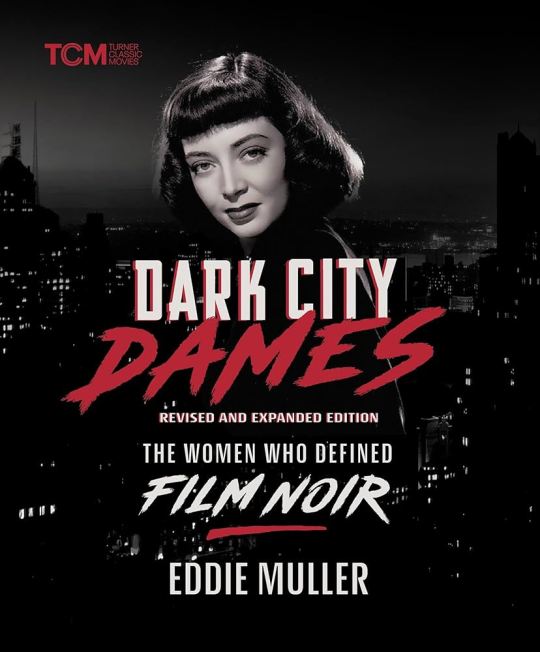
Eddie will be signing copies of the revised and expanded edition of his essential volume Dark City Dames for passholders
8:15
TCL Chinese Theatres, House 1
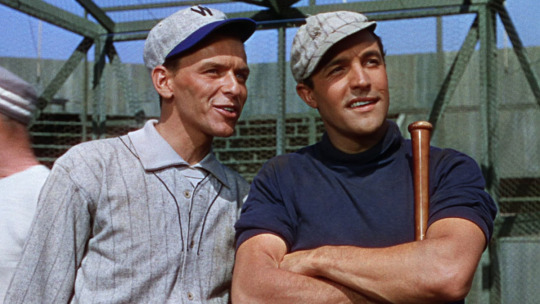
Eddie will introduce TAKE ME OUT TO THE BALLGAME (1949) with his fellow TCM hosts Alicia Malone and Dave Karge. Gene Kelly and Frank Sinatra play members of the fictional Wolves baseball team whose lives are thrown into disarray when the team’s new owner turns out to be a woman (Esther Williams). Directed by Busby Berkeley.
#eddie muller#tcmff#tcmff 2025#chinese multiplex#egyptian theatre#american cinematheque#film noir#dark city dames#the big combo#dan perri#apocalypse now#blue velvet#take me out to the ball game
18 notes
·
View notes
Text
The Tale of the Two Cities
Long ago, in a land divided by ambition and strife, there existed two cities: Piltover, the City of Progress, and Zaun, the Undercity of Shadows. Though the cities shared the same sun and moon, they lived in stark contrast. Piltover stood tall and proud, its spires gleaming in the daylight, a beacon of invention and intellect. Zaun, buried beneath its shadow, was a labyrinth of metal and mist, where ingenuity thrived in chaos, and survival was a daily battle.
The people of Zaun told tales of a brilliant boy named Viktor, a child of the Undercity who dreamed of a better world. Born with a frail body but a mind sharper than any blade, Viktor sought to lift Zaun from its misery. He believed machines, not men, could bring justice and equality. In the dim glow of his workshop, he toiled tirelessly, crafting automatons to aid the weak and heal the wounded.
Meanwhile, in Piltover, a prodigy named Jayce pursued progress with equal fervor. Blessed with wealth and opportunity, Jayce dreamed of harnessing the raw power of Hextech, a mysterious fusion of science and magic. While the world celebrated him as a visionary, Jayce often gazed toward the dark silhouette of Zaun, wondering what miracles and mysteries lay hidden within its depths.
Fate, as it often does, brought the two together. Viktor and Jayce met on a fateful night, their paths crossing over a stolen Hexcore crystal. Though their initial encounter was fraught with mistrust, they soon discovered a shared passion for invention. Together, they built machines that blurred the lines between science and magic, believing their creations could unite their divided cities.
But the cities were not ready for unity. The elite of Piltover viewed Zaun as a breeding ground for crime and disease, while the people of Zaun saw Piltover as a city of tyrants who hoarded wealth and power. The inventions of Viktor and Jayce, instead of bridging the divide, became weapons in an escalating conflict.
The tensions came to a head during the Festival of Progress, an annual celebration in Piltover. Viktor, desperate to prove the worth of Zaunites, unveiled his greatest creation: a sentient automaton named Blitzcrank, designed to save lives and protect the vulnerable. But the Piltover Council, fearing the power of Viktor’s mind and machines, branded him a threat. In their arrogance, they sabotaged his presentation, causing Blitzcrank to malfunction and wreak havoc on the festival.
The people of Piltover called Viktor a madman, and the people of Zaun called him a hero. Heartbroken, Viktor retreated to the shadows of the Undercity, vowing to build a world where the weak would no longer suffer at the hands of the strong. Jayce, torn between his loyalty to Piltover and his friendship with Viktor, became the defender of the status quo, wielding his inventions to maintain order.
And so, the tale of the two cities continues. Piltover rises ever higher, its citizens basking in the light of progress, while Zaun digs ever deeper, its people forging hope in the darkness. Viktor and Jayce, once allies, now stand as symbols of their cities’ eternal struggle: the dream of unity, forever at war with the reality of division.
Yet, some whisper that one day, when the stars align and the Hextech hums in harmony, the two cities may finally become one. Until then, their story serves as a reminder: progress is a double-edged blade, and the brightest light casts the darkest shadow.
22 notes
·
View notes